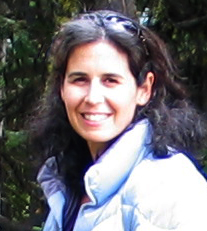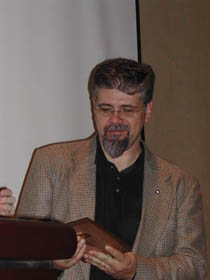THE BIOGEOGRAPHER
Newsletter of the
Biogeography Specialty Group of the Association of American Geographers
Electronic
Version Volume 8 No. 1, Spring 2008
BSG Executive Board
Lori Daniels (President), Univ. of British Columbia
Michelle Goman, Cornell Univ.; Henri Grissino-Mayer, Univ. of Tennessee-Knoxville;
David Butler, Texas State University-San Marcos; Colin Long, University of Wisconsin-Oshkosh, and
Jacqueline Gill (Graduate Student Representative), University of Wisconsin-Madison
Taly Drezner (Secretary-Treasurer), York Univ.; Joy Nystrom Mast (Editor), Carthage College
Teaching Introduction to Physical Geography
I was recently asked to provide some guidance to a new colleague and a graduate student instructor who will be teaching our introductory physical geography classes this academic year. This inspired a flood of memories of amusing, frustrating, exhausting and exhilarating teaching moments that I have experienced as a teaching assistant and professor to more than 3000 first-year students in the past 10 years. As we prepare for the 2008-9 academic year and the first day of classes looms large, here are my thoughts...
Importance of “Introduction to Physical Geography”
Introductory physical geography courses provide the foundation for our academic programs. They are an opportunity to inspire students and recruit them to physical geography and biogeography. Equally important, our courses provide unique exposure to science for non-science majors. This is our chance to encourage these members of our society to critically evaluate media reports and political debates on scientific topics such as global climate change and conservation of biodiversity.
Content and Style of the Course
Lecture and labs serve multiple purposes. They introduce students to a broad range on concepts, theories and applications. At the same time, we can emphasize the fundamental topics and skills that students need to develop to succeed in more advanced physical geography courses.
Lecture content is often clearly defined by the choice of textbook, with many opportunities to supplement with case studies and local examples. Lab content can be more challenging, because we are constrained by a small number of labs sessions per term, the 2 to 3 hours allocated to labs, departmental resources, and opportunities for local field trips.
Many good lab exercises are available from textbook publishers. Alternately, many of us have developed “custom” exercises. For example, in our program, we use a series of lab exercises highlighting the physical geography of British Columbia using local maps, web-based climate, hydrology and vegetation data. These exercises have taken several years and multiple iterations to implement successfully. Regardless of the source of the lab exercises that you choose, explicit connections between lectures and labs will keep students engaged and help them understand the relevance of the labs. Also, try to select exercises that will develop the core skills for students who will continue in physical geography.
Teaching and Learning Styles
Each of us has a unique teaching style that reflects our personality, knowledge, interests and experience. At the same time, it is important to be aware of the demography of your class. Most introductory classes include science and non-science majors, students in their first term of university to those nearing graduation who have yet to complete a required science course. This tremendous diversity of students guarantees a variety of learning styles and approaches to problem solving. By varying your teaching techniques in lectures and labs, you can engage students in a variety of ways. Many universities offer professional development and teaching skills workshops, with specific advice on teaching large, introductory classes. Investing the time in one of these short courses has many long-term benefits for us as educators.
Sustainability
In my experience, two strategies have been essential to successfully multi-task and meet the many demands of teaching a large class:
(1) Clear communication and consistent messages from me and my TAs during lecture and labs, on course websites, and by email; and
(2) Invest time to work cooperatively with my TAs, providing support so that they can be the best lab instructors possible.
Effective and Efficient Communication
Clear communication is critical for the success of large classes. In this era of electronic communications, the course website and email have virtually replaced office hours; however, this has also necessitated clear boundaries about communicating with professors.
A detailed course syllabus sets expectations, clearly defines schedules and course policies, pre-empting many questions and potential problems. Take advantage of the syllabus archive that John Kupfer is developing for the BSG – submit your syllabi now so that they can be shared with others and serve as good examples!
Course websites can be a powerful resource to share information and resources with students, but developing and maintaining a website can take a tremendous amount of time. Consider using a password if you wish to protect your teaching materials and intellectual property from being globally available on the internet. Be aware, once the schedule and precedent is set for adding lecture and lab content to the site, students will expect postings at regular intervals. Expect emails from keen students if you miss posting information on schedule!
I went through a short phase when I attempted to respond to every student email within 24 hours. The week of the first midterm I was overwhelmed by messages such as:
“Hey Lor
Gotta ? 4U - what is the definition of biogeography
CU in class
waving”
I checked my class list. There was no one named “waving” and their email name, hotbunny69, did not help.
I now set boundaries with the students about email communications:
- Email is to be used as a last resort if the student cannot contact me during lectures or my regular office hours.
- Email is a formal form of communication. The subject line must identify the course number; I am addressed as Dr. Daniels; and, students must include their full name and student number at the end of the message.
- Text messages are returned – this saves me from guessing the meaning of the question.
I dedicate time during my office hours to respond to student emails about the course. My office hours are held twice a week (eg, Monday and Thursday) so that students wait no more than 4 days for a response to basic questions about content, schedules or grades (topics often addressed in class or on the course website).
Teaching Assistants
Large introductory classes with multiple TAs pose unique challenges. Many TAs have little teaching experience and are often assigned to introductory classes to gain that experience. At the same time, students have high expectations of their TAs. They expect a confident, knowledgeable lab instructor, equal learning opportunities and comparable grading among lab sections. To ensure that labs are as equitable and successful as possible, I depend on my TAs to be motivated and committed to ensuring the highest quality learning experience for our students, regardless of their level of experience. In return, I aim to support my TAs to the best of my ability to help them fulfill that commitment.
In support of my TAs, I provide teaching resources in advance of the course: textbook, lab manual, answer keys for the lab exercises, and a teaching guide for each of the labs. TAs are to complete each lab exercise in preparation for weekly lab meetings. During meetings, we discuss the main concepts and skills to be taught, teaching methods, and identify topics that that have challenged students in the past. I also gain informal feedback from the TAs about progress in the course and answer questions or facilitate discussions about teaching and classroom management.
Designating a “Lead TA”, who has abundant experience with the course, is an excellent way to share time-consuming administrative responsibilities such as coordinating grading, grade entry in spreadsheets, monitoring teaching supplies in lab classrooms, and ensuring all lab equipment is in working order.
Strategies for TA Success
Here are some pointers for graduate students who wish to gain experience as a teaching assistant...
§ Request an initial meeting with the instructor of the course to determine the course goals and your role as a TA. Ask to follow up with regular meetings throughout the term to discuss individual lab exercises.
§ Ask for clear guidelines for grading exercises, assignments and exams. This is essential to ensure equitability among lab sections.
§ For each exercise that you will teach, be prepared to teach key concepts and demonstrate required skills. Read the lab manual carefully. Complete each exercise and compare your answers to those in the answer key from the course instructor. Identify topics that are likely to challenge students and identify multiple ways to teach them these topics.
§ Whenever possible, be the TA for the same course more than once. This will reduce your preparation time and allow you to improve your teaching skills over the long term.
In many ways, I find our introductory courses the most demanding of me, but they can also be tremendously rewarding.
Best wishes with your classes in 2008-9!
Lori Daniels, BSG Chair 2007-8
Proud Recipient of the Killam Teaching Award at UBC in 2007
Graduate Student Representative Column
Serving as the Biogeography Specialty Group’s (BSG) student representative has been an excellent experience and a great pleasure, and I would like to thank all of you for your support this past year. Thanks also to all the students who voted for the next student representative, and congratulations to Jacquelyn Gill (Wisconsin, Madison), who will be the new rep! I am certain that she will do a fantastic job. If you are a student with any interest in learning more about the AAG and BSG, would like experience organizing a panel session, or want to meet more biogeographers (both students and faculty), then I would definitely encourage you to run for the Grad rep position next year – get involved!
When Chad Lane became the first student representative for the BSG three years ago, he initiated a student-focused panel session at the AAG. The first panel was aimed at providing advice about obtaining jobs in Biogeography, and the second was helping students and new faculty obtain grants for teaching and research. Last year I had the pleasure of organizing the panel for the conference in Boston around the theme of “Succeeding as a Biogeographer.” The theme was chosen based on graduate student and faculty responses to a survey about potential topics of interest. There was a great diversity of interests, and so I chose to keep the session broad and to recruit panelists from a variety of backgrounds. The six panelists included Jake Bendix (Syracuse), David Cairns (Texas A&M), Larry Handley (U.S. Geological Survey), Amy Hessl (West Virginia), Colin Long (Wisconsin Oshkosh), and Rosemary Sherriff (Kentucky). The panel offered their thoughts about job hunting, teaching versus research positions, balancing work & family life, and a host of other topics, and there was excellent dialog among panelists and faculty and students in the audience as well. The panel was a great success due to the support and openness of the faculty and the active participation of all the students who attended – thanks so much to all of you who participated. I hope that you will get in touch with Jacquelyn if you have ideas about a panel that you would like to see in Las Vegas.
If you have any suggestions or thoughts that you would like to share about the BSG before Jacquelyn begins her term, please don’t hesitate to send me an email (jennmarlon@gmail.com). If you would like to join the BSG listserv, please email Chad Lane (chad.lane@lawrence.edu). Again, thanks for all your support this past year!
Jennifer Marlon, Grad Student Representative, 2007-2008
BSG Annual Business Meeting
Minutes of the Annual Meeting of the Biogeography Specialty Group Association of American Geographers April 16, 2008, Boston, MA. |
Lori Daniels |
1. Welcome Lori Daniels, President of the BSG, called the meeting to order at 7:04pm and welcomed the audience. More than 7000 people are registered at this year’s AAG.SESSIONS: This year, 36 sessions were sponsored or co-sponsored by the BSG. Congratulations and thanks to the many people who organized sessions. Members are encouraged to come up with ideas for sessions and field trips for next year’s meeting in Las Vegas. Hopefully we will have at least another 36 sessions.BSG GEOGRAM DISCUSSION FORUM: Communications among BSG members is usually by email through the AAG’s discussion forum. A set of instructions were provided for people to pick up that have not been receiving “geograms” from the BSG, to subscribe to the forum. BSG WEBSITE: Lori thanked John Kupfer for continuing to maintain our website. It can be accessed via www.biogeographer.org, or at http://people.cas.sc.edu/kupfer/bsg.html. John Kupfer continues to request syllabi online for biogeography courses. |
2. BSG Elections Lori introduced Rosemary Sherriff, BSG Board Member and Organizer to present the results of the 2008 BSG board elections. Thank you to all who were willing to serve on the BSG board. The new board members are David Butler (Texas State University, San Marcos) and Colin Long (University of Wisconsin, Oshkosh), and Jacqueline Gill (University of Wisconsin, Madison) is the new student representative. Congratulations to the winners. Lori offered thanks to Catherine Yansa, Rosemary Sherriff and Jennifer Marlon for serving on the board.
|
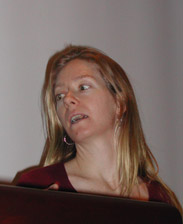 Rosemary Sherriff |
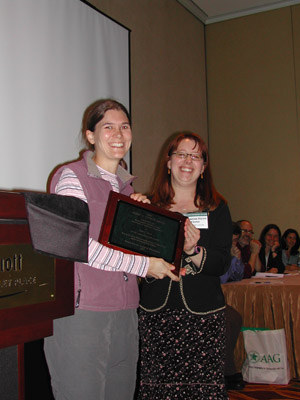 |
3. Cowles Award Lori introduced Catherine Yansa, BSG Board Member and Organizer. Catherine noted that there is no Parsons submission this year as the award is only given out periodically, not every year. For this year’s 2008 Henry Cowles Excellence in Publishing Award in Biogeography, there were 5 judges, which Catherine thanked. The winner was Kim Diver (Syracuse University) for her paper in the Journal of Biogeography entitled, “Not as the crow flies: assessing effective isolation for island biogeographical analysis.” Kim came up and accepted the award. She thanked the BSG, as well as J. Bendix and M. Lomolino. Kim noted that she will be continuing her research in Canada and Panama. Lori noted that all four submissions this year were excellent. |
Kim Diver and Catherine Yansa |
|
4. Student Presentation Awards Lori introduced Michelle Goman, BSG Board Member and Organizer. Michelle announced the 2007 winners: 2007 Ph.D. Awards ($400 each): There was a tie and two awards were given at the Ph.D. level: Ryan Danby, University of Alberta, Plant physiology influences landscape pattern at subarctic alpine treeline Scott Markwith, University of Georgia, Multi-scale analysis of Hymenocallis coronaria genetic diversity, genetic structure, and gene movement under the influence of unidirectional stream flow. 2007 Masters Award ($200): Chad Yost, Saint Cloud State University, Diagnostic phytolith evidence for the presence and abundance of wild rice (Zizania sp.) from central Minnesota lake sediments. Poster Award ($100): Neil Toth, Indiana State University, Climate reconstruction from eastern hemlock (Tsuga canadensis) in central Indiana. Michelle thanked all of the judges. |
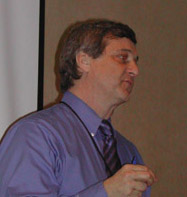 |
5. Student Research Grant Awards Lori introduced Henri Grissino-Mayer, BSG Board Member and Organizer. Henri provided an update on the 2008 grant competition. This is the first year we have done it with an extended deadline; applications were due April 1, 2008 and winners will be announced in May, in time to support research during the 2008 field season. There was a total of 15 proposals (11 Ph.D., 4 Masters), and 6 reviewers judged the Masters and 6 the Ph.D. competition. Henri noted that he had to step down this year from the judging process due to conflict of interest, with 5 of the 15 proposals coming from his home institution (University of Tennessee Knoxville). Henri thanked all of the judges, and said he’d like to be flooded next year with proposals! Henri reminded the audience that grant writing is very important, and reminded applicants not to forget to include their mini-CV with their application.
Henri Grissino-Mayer |
6. Graduate Representative Lori called on Jennifer Marlon, BSG graduate student representative on the Board. Jennifer encouraged continued organization of panels, and discussed the panel session she organized for this 2008 AAG meeting, ‘Succeeding as a Biogeographer’. D. Cairns, J. Bendix and others will be on the panel, and topics will include publishing, proposal writing, getting a job, and teaching, among others. Lori encouraged people to attend.
|
|
|
7. BSG Newsletter Lori invited Duane Griffin, Editor of The Biogeographer of at least eight years, up to the front. Lori noted that it takes Duane 30-40 hours to produce the newsletter. In addition, as an ex officio (non-voting) member of the board, Duane has served as tie breaker and judge in other areas throughout the years. Lori thanked Duane for his outstanding service to the BSG and presented him with the plaque. The crowd gave Duane a standing ovation. Duane accepted the plaque and offered thank to the BSG. He also reminded the audience to continue sending pieces to Joy Nystrom Mast, our new incoming Editor. Lori thanked Joy for volunteering to be the new editor forThe Biogeographer, and also encouraged the membership to submit materials to Joy at jmast@carthage.edu. The Biogeographer can be found via www.biogeographer.org, or at: http://www.departments.bucknell.edu/geography/The_Biogeographer/. |
8. BSG Finances and Treasurer’s Report Lori called upon Taly Drezner, BSG Treasurer, to present the treasurer’s report. From March 2007 to February 2008 we paid out $4487.61 and collected $2450.00 in dues, paying out $2037.61 more than we took in. As of February 2008, we had a balance of $3742.51.The AAG has been encouraging specialty groups to spend incoming dues and not carry large balances from year to year, so we have given more awards. Taly noted that although we intend to give out a certain number of awards, we may choose to give out more than the allotment if we have especially strong submissions, particularly as long as we aim to reduce our fund surplus. Taly encouraged graduate students to submit the research and proposals for consideration. Taly provided a paper copy of the full account details for anyone interested in specific budget information. Notes: Funding for the student awards from last year (2007) are as follows: · Doctoral paper presentations - $400.00 · Master’s paper presentations - $200.00 · Poster presentation - $100.00 · Doctoral Research grant - $1000.00 (2 awarded) · Master’s Research grant - $500.00 In addition, the BSG provides $500.00 to the graduate student representative on the board to support travel to the AAG annual meeting. Lori thanked Taly for her service, and noted that Taly also serves as ex officio member of the board, and thus contributes to the judging of student submissions and other BSG business. |
|
9. Announcements
· George Malanson encouraged submissions to Physical Geography. The turn around time is rapid; George notes the last paper went from original submission to press in 10 weeks. George also promoted the new journal, Geography Compass. George talked about this new unique journal with a different purpose than many other journals. Geography Compass publishes reviews, but rather than being aimed at cutting edge researchers, the reviews are aimed for a general audience and should be useful for teaching, both as a review for students, or to bring a faculty or student up to date on a particular topic that is not working primarily in that area of research. Since the journal is published online, there is almost unlimited opportunity with color graphics; with most articles being about 5000 words, and will soon be on ISI. Articles are commissioned, so George asks that you contact him first with your idea. Biogeography manuscripts have already been published by D. Cairns, K. Parker, M. Blumberg, T. Drezner and others. George encouraged solicitations to both journals, and noted he’d like to see more paleo or Holocene submissions to balance the more modern pieces they presently have.
· Joy Nystrom Mast encouraged paper submissions to the Annals of the AAG. Because there are few physical geography submissions, there is about a 50% acceptance rate for these papers as the editor is more likely to work with submissions to make them acceptable for publication.
· Jacqueline Gill - International Biogeography Society (IBS): Jacqueline encouraged participation in the IBS and attending their meeting. There are 4 symposium topics and contributed talks and poster sessions. Lori called on Joy Mast for additional information. Joy noted how there is always only 1 talk at a time, as well as posters where everyone gets to mingle. The meetings are quite under-represented by geography. Duane Griffin noted that the biologists are interested in us and in our attendance. The 4th International Conference will be held from 8-12 January, 2009 in Mérida, México. http://www.biogeography.org/meetings.htm.
· Northern Illinois University has an opening for a visiting assistant professor for the Fall. Flyers were provided.
· David Butler announced that at the Mountains specialty group meeting, George Malanson was receiving a career award.
10. Discussion for BSG
BSG members are invited to share their hopes for the future of the specialty group and their concerns. How might the BSG move into new growth and better serve our members?
· Sally Horn said that it would be helpful to have images and diagrams available online for teaching, however the group noted that there are uncertain copyright concerns. Lori reminded the group to email John Kupfer syllabi to post.
· Catherine Yansa said that other specialty groups meet in small groups and give presentations that they subsequently discuss and share methods and learn new techniques. Catherine noted that this normally occurs as a 1 or 2 day workshop for teaching and research exchange of ideas.
· Lori Daniels and Jacqueline Gill suggested a graduate student and faculty panel on fieldwork. Other fieldwork topics/variants included: international fieldwork, fieldwork in public and protected areas, leadership, permits, fieldwork in the backcountry or areas that are difficult to access, methodology tips and what to do when things don’t work out as planned when you get there, logistics (e.g. how many field assistants needed), animals and humane treatment, and community research and volunteers.
· Jacob Bendix mentioned the overlap between the BSG and other specialty groups, such as geomorphology and that we need to strenuously suggest to the AAG to look at membership before scheduling. Lori noted that there are limited lunch and evening slots. Perhaps physical geographers should get together to decide these things. Lori will send out an email asking members to list all of their specialty group affiliations. Sally Horn noted that now there is also a major overlap with the new Paleoenvironmental Change specialty group.
· Jacqueline Gill noted that there are many different BSG websites and it would be useful to try to remove some of the outdated ones. Lori noted that this is a problem but not all websites are easily removed.
· Jennifer Marlon (BSG graduate student representative) announced the deadline for the upcoming DISCCRS symposium (www. disccrs.org) for recent Ph.D.s studying climate change and said that flyers are available for those interested.
· The First American
Dendrochronology Conference (Ameridendro) will be
held on the UBC campus June 23-27, 2008. In conjunction with that
meeting, the 18th Annual North American Dendroecological Fieldweek at Apex Mountain (4 hours from Vancouver)
from June 13-21, 2008 will be held. The planners for Ameridendro and the fieldweek stayed after the BSG meeting to
discuss plans for these upcoming events.
11. Physical Geography Reception
Lori wrapped up discussion with a final announcement inviting all members to the physical geography party. The BSG co-sponsors this party, which generously provides free snacks and beer. It is open to everyone at the AAG.
12. Adjourn to the Physical Geography Reception
Lori thanked everyone for coming and contributing their ideas. The meeting was adjourned at 8:00pm exactly to the Physical Geography reception.
Taly Drezner,
Secretary-Treasurer
York University
Awards
Henry Cowles
Excellence in Publishing Award
Kim C. Diver, Denison
University won the Parsons Award competition for her paper Not
as the crow flies: assessing effective isolation for island biogeographical
analysis (June 2008 Journal
of Biogeography 35: 1040-1048).
Abstract:
Aim To evaluate the role of island isolation in explaining the
distribution of vascular plant species in a dense freshwater archipelago,
specifically comparing conventional measures of island isolation with landscape
measures of island isolation.
Location Data were collected from 35 islands within Massasauga Provincial Park on the eastern shores of the Georgian Bay, Ontario, Canada.
Methods Sampled islands were located using stratified random selection based on location and size variation. The number of species was recorded along stratified random transects. Island isolation variables included distance to the mainland, distance to the nearest island, largest gap in a stepping-stone sequence, distance to the closest upwind point of land, and a landscape measure of island isolation. The landscape measure of isolation was quantified as the percentage of the land area within 100, 250, 500, 1000, 1500 and 2000 m of each island's perimeter. The isolation variables were calculated within a geographical information system (GIS). Dependent variables in the regression analyses included species richness, the logarithm of species richness and residuals of the species–area relationship. Independent variables included island isolation variables and their logarithmic transformations.
Results Isolation plays a role, albeit small, in explaining species richness in the study area. In the regression analyses, the landscape measure of isolation provided a better fit than conventional measures of island isolation. Islands with less land than water within a 250-m buffer were more effectively isolated and had fewer species present than islands surrounded by a greater proportion of water.
Main conclusions Consistent with the species–isolation relationship, fewer species were present on more isolated islands within the Massasauga study area, as elucidated using a series of island buffers in a GIS. Applying a landscape measure of isolation to similar dense, freshwater archipelagos may elucidate species–isolation patterns not evident through conventional, straight-line distance measurements of island isolation. The low value of the regression coefficients as well as the isolation history and high density of the Massasauga islands suggests caution in extending the results, especially to dissimilar archipelagos.
Student Awards
BSG Student Paper and Poster Competition
The BSG student paper and poster competition held at the spring 2008 AAG
meeting in Boston had a total of 16 participants (11 Ph.D. and 5
M.A./Undergraduate students). The
variety of subjects covered and the quality of the work presented in Boston was
outstanding. I would like to thank all the student participants for a great
competition and of course a big thank you goes to the many judges who
volunteered their time at the meeting to evaluate the papers.
The 2008 winners are:
Mathew Valente,
Ph.D. paper ($200 award) The University of Tennessee, Knoxville: Genetic
Variation, Diversity, and Phylogeography of the
Southeastern US - Mexico Cloudforest Disjunct Vine Schisandra glabra (Brickell) Rheder (Schisandraceae)
Joanne Stewart, MA/UG paper ($200 award) University of Denver: Distribution and differential habitat use of bats along a prairie riparian corridor in Eastern Montana.
Anne Trainor, Poster competition ($100 award) University of North Carolina: Influence of Landscape Characteristics on Long Distance Dispersal Events for Red-cockaded Woodpecker (Picoides borealis)
The call for participation in next year’s competition will appear in the Fall Biogeographer newsletter.
Michelle Goman, Dept. Earth and Atmospheric Sciences, Cornell University
BSG Student Paper and Poster Competition Organizer
BSG Student Grant Competition
The BSG 2008 student proposal award competition held this spring had a total of
11 participants (11 Ph.D. and 4 M.A. students). The quality of proposals was impressive. I would like to thank the
judges who volunteered their time to evaluate the proposals. I special thanks goes to Colin Long for
co-chairing the competition.
BSG Ph.D. Proposal Award
Competition:
Winner: Jacqueline Gill ($1000 award)
Advisor: Jack
Williams
University:
University of Wisconsin-Madison
Title:
Counting spores from the dung fungus Sporormiella in
archived pollen slides to reconstruct the spatiotemporal patterns and
ecological context of the North American megafaunal extinction.
Winner: Kerry Malm ($500
award)
Advisor: Tom
Veblen
University:
University of Colorado
Title:
Modeling mountain pine beetle phenology in northern
Colorado and the potential impact of climate change.
Starting with the 2009 proposal award competition, the BSG has added the following wording to the application instructions:
"In the CV, briefly list past and current funding (both the agency and the dollar amount) that has supported this proposed research. Awards given by the BSG are partially based on demonstration of need for BSG funding. Failure to disclose your past and current funding (including funding that may have arrived during this competition) for this research could result in disqualification from this competition.”
The call for proposals for the 2009 competition will appear in the Fall 2008 Biogeographer newsletter.
Henri
D. Grissino-Mayer, University
of Tennessee
BSG Student Grant
Competition Organizer
Calls for Nominations and Participation
The Fall 2008 Biogeographer will have the information for the
2009 student paper and grant competitions, the Parsons and Cowles award
competitions, and the election materials for the next BSG president, two board
members, and the student representative.
News
International
Biogeography Society
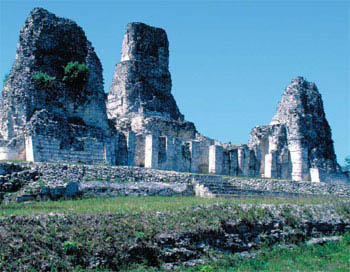 |
The International Biogeography Society (IBS) Board invites you to plan ahead now to attend the 2009 biennial meetings of the IBS in Merida, Yucatan, Mexico from 8 to 12 January 2009. Meeting registration and abstract submission are now available on the following website: http://www.biogeography.org/html/Meetings/index.html. Pre-conference workshops include
The symposia for the 2009 meeting are:
Pre-conference excursions will be guided to Dzibilchaltun ruins and Progresso town and Ria Celestun (famous for their flamingos), while post-conference field trips will be to Chichen Itza ruins, Loltun caves, and Uxmail ruins. |
Merida is in the midst of cultural, natural, historical, and geological riches. The beautiful colonial "White City" was founded in January 1542 on the ruins of the Mayan city of T'ho, and is only 120 km from the archeological wonders of Chichen Itza. The center of the Chicxulub Crater, formed from an asteroid impact 65 mya and implicated in the K-T extinctions, is located 20 km outside of Merida (in the pueblo of Chicxulub). Several biosphere reserves are within easy distance of Merida (e.g., Celestun and Rio Lagarto Biosphere Reserves).Check out these and other enchanting features of Merida on the web (e.g., http://www.visitmexico.com/wb/Visitmexico/Visi_Merida). Climate should be ideal in January, and the IBS is planning field trips to explore the natural and archeological wealth of the region. Registration for the Mexico meeting in January 2009 has just opened. Discounted early registration lasts until October.
Editor’s Note: I have attended the all the IBS biennial meetings so far and can say that they are quite remarkable. There are no overlapping sessions, excellent field trips, and a high quality in the symposium talks. – Joy Nystrom Mast
If you have not yet joined IBS, you might benefit from joining the International Biogeography Society. For more information, go to their website at www.biogeography.org. Membership in IBS is only $40.00 per year for practicing biogeographers and $30.00 per year for students, and includes: 1) reduced cost of registration fees to attend IBS conferences, 2) discounts (up to 20%) on books published in association with IBS, 3) free online access to Blackwell Publishing's four biogeography journals: Journal of Biogeography, Global Ecology & Biogeography, Diversity & Distributions and Ecography, journals covering all aspects of biogeography and ecology, and 4) a 20% discount on access to two additional Blackwell Publishing journals: Journal of Avian Biology and Oikos.
Bekker, Matthew F. and D.M. Heath. 2007. Dendroarchaeology of the Salt
Drezner, Taly D. and Balling Jr., Robert C. 2008. Regeneration cycles of the keystone species Carnegiea gigantea are linked to worldwide volcanism. Journal of Vegetation Science 19: 587-596. **See also the cover photo!**
Fritschle, Joy A. 2008. Reconstructing historic ecotones using
the Public Land Survey: the lost prairies of
Hart, Justin L., Sally P. Horn, and Henri D. Grissino-Mayer.
2008. Fire history from soil charcoal in a mixed hardwood forest on the
Hart, Justin L., Saskia L. van de Gevel, and Henri D. Grissino-Mayer.
2008. Forest dynamics in a natural area of the southern Ridge and Valley,
Hart, Justin L., and Henri D. Grissino-Mayer.
2008. Vegetation patterns and dendroecology of
a mixed hardwood forest on the
Hart, Justin L., Saskia L. van de Gevel, David F. Mann, and Wayne K. Clatterbuck.
2008. Legacy of charcoaling in a Western Highland Rim forest in
Hart, Justin L. 2007. Biodiversity and edge effects: An activity in landscape ecology. Journal of Natural Resources and Life Sciences Education 36: 103–106.
Shankman, David and Justin L. Hart. 2007. The Fall Line: A physiographic-forest vegetation boundary. Geographical Review 97: 502–519.
Ziegler, Susy Svatek, Evan R. Larson,
Julia Rauchfuss, and Grant P. Elliott. 2008. Tree
Recruitment during Dry Spells at an Oak Savanna in
Research Notes
Geography Compass
George
P. Malanson, University of Iowa
Geography Compass publishes peer-reviewed surveys of important research and current thinking from across the entire discipline. The journal's emphasis is on state-of-the-art reviews, supported by a comprehensive bibliography and is accessible to an international readership of geographers and scholars in related disciplines.
Section on Biogeography
Biogeography is one of 13 sections in Geography Compass. Section editor, Glen MacDonald helped develop Geography Compass and was responsible for organizing the initial round of articles. He has passed on the responsibility to the new section editor George Malanson, who is now developing a publishing plan for the year ahead. The internationally expanding editorial board currently includes Miguel Bastos, Mark Blumler, David Cairns, Taly Drezner, Neal Enright, Georg Grabherr, Katrina Moser, Patrick Moss, Kathleen Parker, Jonathan Sadler and Alan Taylor.
Readership
In biogeography, we consider the real intended audiences are those teaching biogeography who need to keep-up with developments outside their own research domain, new graduate students who would like a good introduction to a topic, and advanced undergraduates who could be assigned some outside reading.
Benefits of Geography Compass
Geography Compass is designed to help all academics and advanced students involved in teaching and research: to teach in a new or unfamiliar area, to keep- up with developments in their own field and areas related to it, and ensure that students are exposed only to quality-controlled online content. The reviews will also be useful to those preparing lectures, writing proposals, or examining the history of an idea. Reviews can cover a broad topic and are specific enough to provide insight into examples of current research. Most reviews are about 5000 words and, being online, can include a wide variety of graphical material.
A Selection of Articles in Biogeography
Recently published and soon to appear forthcoming articles include:
· Expanding Biogeographic Horizons with Genetic Approaches, by K. Parker & S. Markwith
· The Population Dynamics of Columnar and Other Cacti: A Review, by T.D. Drezner & B.L. Lazarus
· Neutral Landscapes: Bases for Exploration in Landscape Ecology, by Q. Wang and G.P. Malanson
· Landscape modeling as a tool for understanding the influence of southern pine beetle infestations in structuring southern Appalachian forests, by D.M. Cairns – link to abstract when published.
Articles on Biogeography for Geography Compass are commissioned by, or unsolicited articles that meet the aims of the journal can be sent to the section editor, George Malanson. For further information visit
Email: george-malanson@uiowa.edu
John Kupfer continues to request syllabi online for biogeography courses to be included on the biogeographer specialty group’s website, which can be accessed via www.biogeographer.org or at http://people.cas.sc.edu/kupfer/bsg.html.
Additional Teaching Tools of interest:
PaleoMap Project - http://www.scotese.com/
Provides maps for visualizing the position of continents at different times in the history of the Earth.
Species Distribution Modeling - http://biodiversityinformatics.amnh.org/index.php?section=sdm
Provides practical advice and resources to those interested in developing and applying species distribution models.
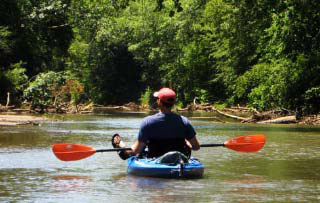 |
Field Diary: Summer 2008 Scott Markwith, Florida Atlantic University Department of Geosciences, is posting an online semi-daily account of his experiences conducting field research in the Broad River watershed in northeastern Georgia. His research is designed to determine the influence of various gene flow patterns on spatial genetic diversity, isolation-by-distance, and genetic structure of aquatic plant populations in stream networks. He will share his adventures after every day spent kayaking, and his thoughts and observations about research and the ecological, morphological, and social characteristics of the watershed. Thanks for reading, and Scott hopes you enjoy it as much as he will enjoy his time on the river. URL: http://markwith.freehomepage.com/broadriver.html |
With much gratitude the Biogeography Specialty Group thanks Duane Griffin for serving as the editor
of The Biogeographer for at least the past eight years. Duane accepted a plaque for outstanding
service at the 2008 AAG meeting in
I am delighted to now serve as the editor for The Biogeographer. I encouraged the BSG membership to submit materials to me at jmast@carthage.edu. The Biogeographer can be found via www.biogeographer.org, or at http://www.departments.bucknell.edu/geography/The_Biogeographer/
Joy Nystrom Mast
Carthage College
Past editor’s note
It’s with been a pleasure serving as The Biogeographer’s fifth editor. Lee Henry Slorp was the first, starting in 1981. Susan Woodward took over in 1985, who passed the pen to Mike DeMers in 1991, who passed it to Eric Edlund, in 1997. I took over in 2000, and it really has been a blast working with you all and watching the BSG grow. That said, I’m delighted to pass the editorship to Joy’s capable hands.
I won’t be leaving The Biogeographer altogether. As editor, Joy is responsible for all newsletter content, but I’ll continue to do the web production. That means that the url for the newsletter will stay the same, and that any glitches or technical errors are my doing, not Joy’s. I’ll appreciate your bringing them to my attention.
Thank you all for contributing materials over the years, and thanks to the BSG board for the nice plaque. And a special thanks to Bucknell’s fantastic IT staff. I don’t think we’ve been offline for more than a couple of hours in the entire past eight years. That’s a pretty remarkable record. They’re the best.
Duane Griffin
Bucknell University
Submission Guidelines
Submissions should be sent directly to the editor as email attachments in one
of the following formats: html, MS Word, or RTF (single spaced, 12 pt. Times
Roman font). Limit special formatting to bold and italics, ensuring that all
links are complete and any subfolders or documents are included. If submitting
items for more than one section of the newsletter (news, notes, publications),
send each in a separate email with the section identified in the subject line.
Bear in mind that your editor generally just cuts and pastes whatever he gets,
so please spell-check and proofread your submissions carefully. Submissions
should be concise and written in a style consistent with the rest of the
newsletter.
Notes and News Items. News items can be personal, departmental,
institutional, or simply biogeography-related stories from the press. Notes are
intended to convey topical information of interest to the BSG community. Topics
for these categories include:
- Research Notes: new projects and progress reports or general research-related ideas and issues.
- Field Notes: recent field work or field trips or retellings of classic tales from the field (embellishments welcome).
- Course Notes: news, announcements, or articles related to teaching biogeography or pedagogical issues affecting the discipline.
- Book Notes: book reviews or announcements.
- Miscellaneous Notes: anything that doesn't fit in any of the other categories.
News items should generally be less than 500
words and notes less than 1500. Please check with the editor before submitting
longer items. Images should be sent as separate files (do not embed them in
text documents) following the guidelines below.
Recent Publications
Format bibliographic entries following the Chicago B style used in the
Annals. Only publications that have actually appeared in print or online will
be listed, so please do not submit in-press items until you have page numbers
or a permanent URL.
Images
Photos should be jpeg or png format with a minimum
resolution of and no larger than 400 pixels wide or tall. Larger images (up to
800 pixels wide) will be considered if appropriate. Maps and other graphics can
be larger if needed for clarity, but in no case should exceed 800 pixels wide.
Edit your images to enhance contrast, brightness, and color balance. (Picasa is a free
image organizer that includes basic editing tools that can simplify this task;
be sure to use the "Export" command after editing.)
